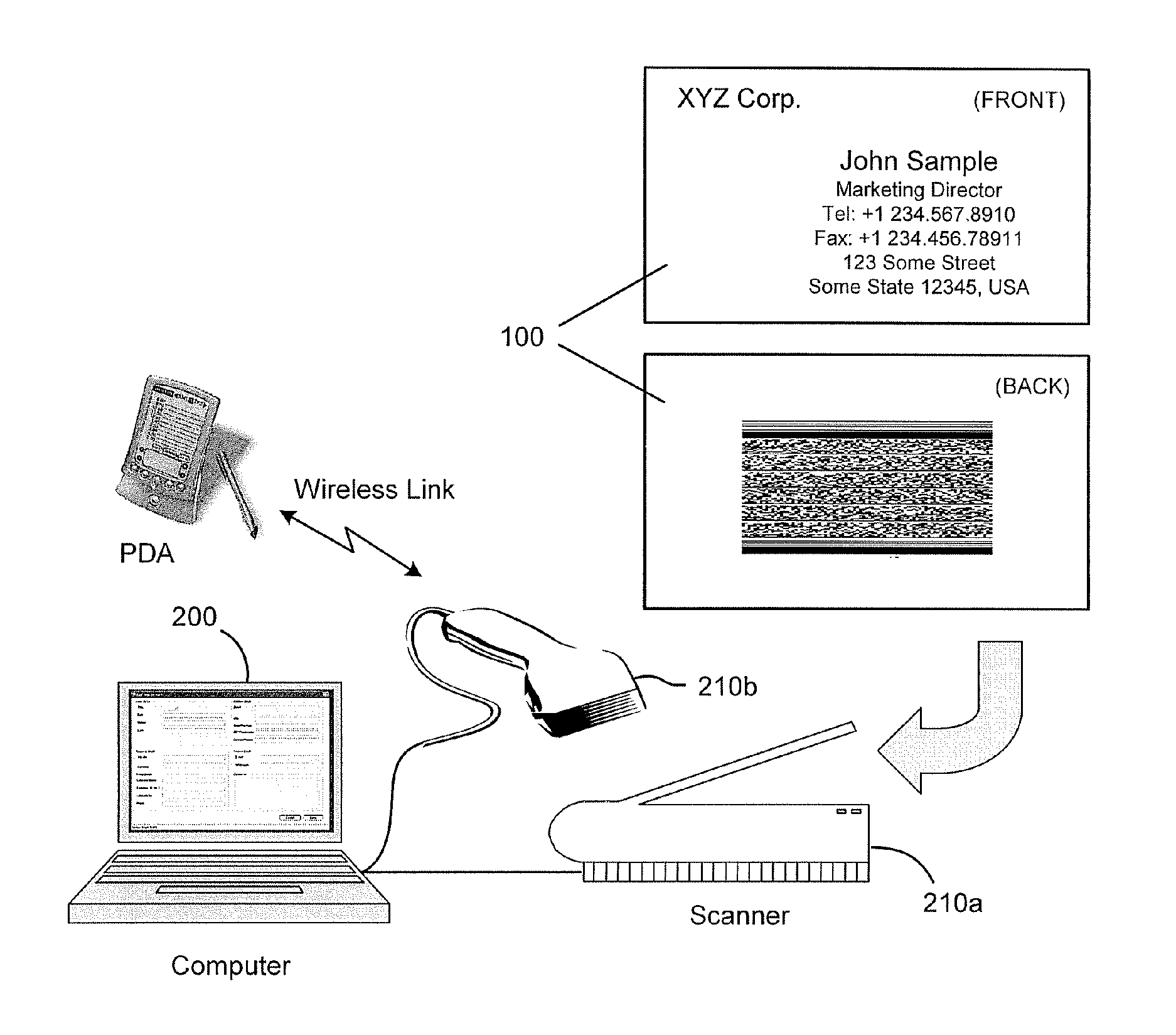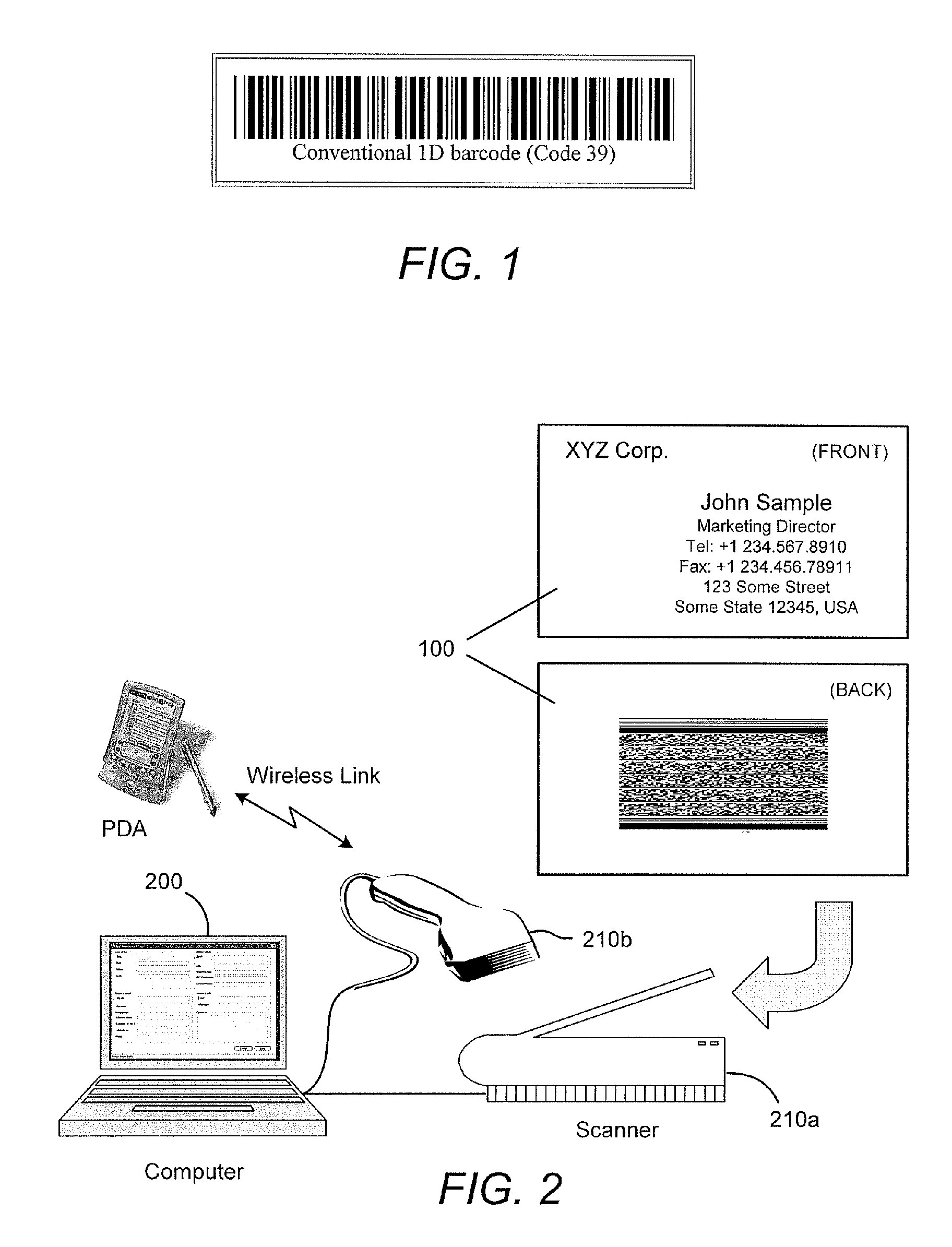Method and system for using barcoded contact information for compatible use with various software
a technology software, applied in the field of barcoded contact information for compatible use with various software, can solve the problems of difficult management, burdensome and time-consuming, and the inability to find the contact information relating to a specific card, and achieve the effect of being easily imprinted on the material
- Summary
- Abstract
- Description
- Claims
- Application Information
AI Technical Summary
Benefits of technology
Problems solved by technology
Method used
Image
Examples
first embodiment
[0022] Referring now to FIG. 2, a system for reading, converting, and storing business contact information without the need for additional user intervention is described in accordance with the present invention. An exemplary business card is shown generally as 100 that contain a variety of contact information printed on the front of the card. The contact information can include information divided into separate fields such as company name, first name, last name, title, address, city, state, zip code, country, phone number, fax number, email address, a website address etc. It should be understood that the invention is not limited to the information shown but can comprise other types of information such as graphics, trademarks or logos, for example. All data on the business card, or as much as desired, can be encoded in a high density two-dimensional barcode containing a machine-readable representation of the contents of the card, which as shown in the figure is imprinted on the back ...
second embodiment
[0070]FIG. 4 shows such an arrangement for printing out registration nametags for an event, conference, tradeshow or similar event in accordance with the present invention. Major events such as tradeshows often require the attendees to register prior to attending the event since it enables the organizers to conveniently keep track of everyone attending the event. The attendee typically enters his registration details into a computer terminal or a portable computing device at the registration area that generally includes personal information such as his or her name, affiliated company, address etc. The registration system can be used for registering attendees in advance or for those registering upon arrival at the event. The registration information is stored in a database for storage and processing by the computing device for event organizers. The computing device can be in wireless communication with other devices e.g. via Bluetooth. Once the information is in the system a nametag ...
third embodiment
[0075]FIG. 5 shows an exemplary system using a mobile phone for obtaining contact information from a barcode in accordance with the invention. The embodiment implements a mobile phone having a built-in digital camera for capturing the image of the barcode. As digital cameras become more and more pervasive in everyday life, it is possible to use them to scan documents into digital images. By way of example, it is possible to use the CCD in digital cameras that come with many of present-day mobile phones as a handheld scanner. The image is transmitted wirelessly from the mobile phone to the computing device for analysis, decoding and conversion of the data for automatic export to various PIM applications in the manner described in the previous embodiments. Furthermore, the embodiment enables one to scan a business card with a printed two-dimensional barcode such that the contact information is automatically entered into the address book of the phone.
PUM
 Login to View More
Login to View More Abstract
Description
Claims
Application Information
 Login to View More
Login to View More - R&D
- Intellectual Property
- Life Sciences
- Materials
- Tech Scout
- Unparalleled Data Quality
- Higher Quality Content
- 60% Fewer Hallucinations
Browse by: Latest US Patents, China's latest patents, Technical Efficacy Thesaurus, Application Domain, Technology Topic, Popular Technical Reports.
© 2025 PatSnap. All rights reserved.Legal|Privacy policy|Modern Slavery Act Transparency Statement|Sitemap|About US| Contact US: help@patsnap.com



